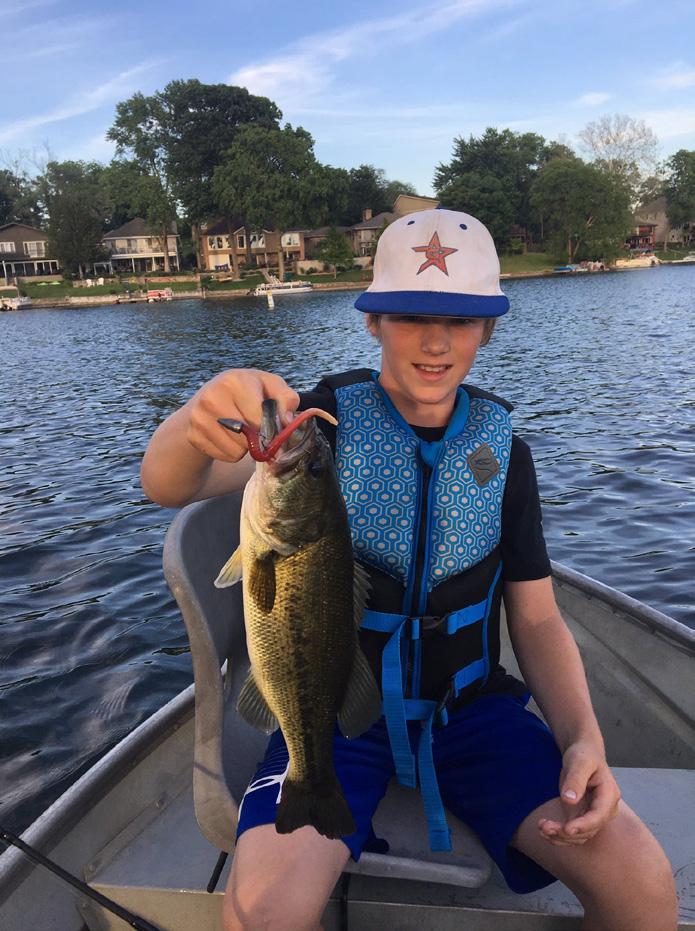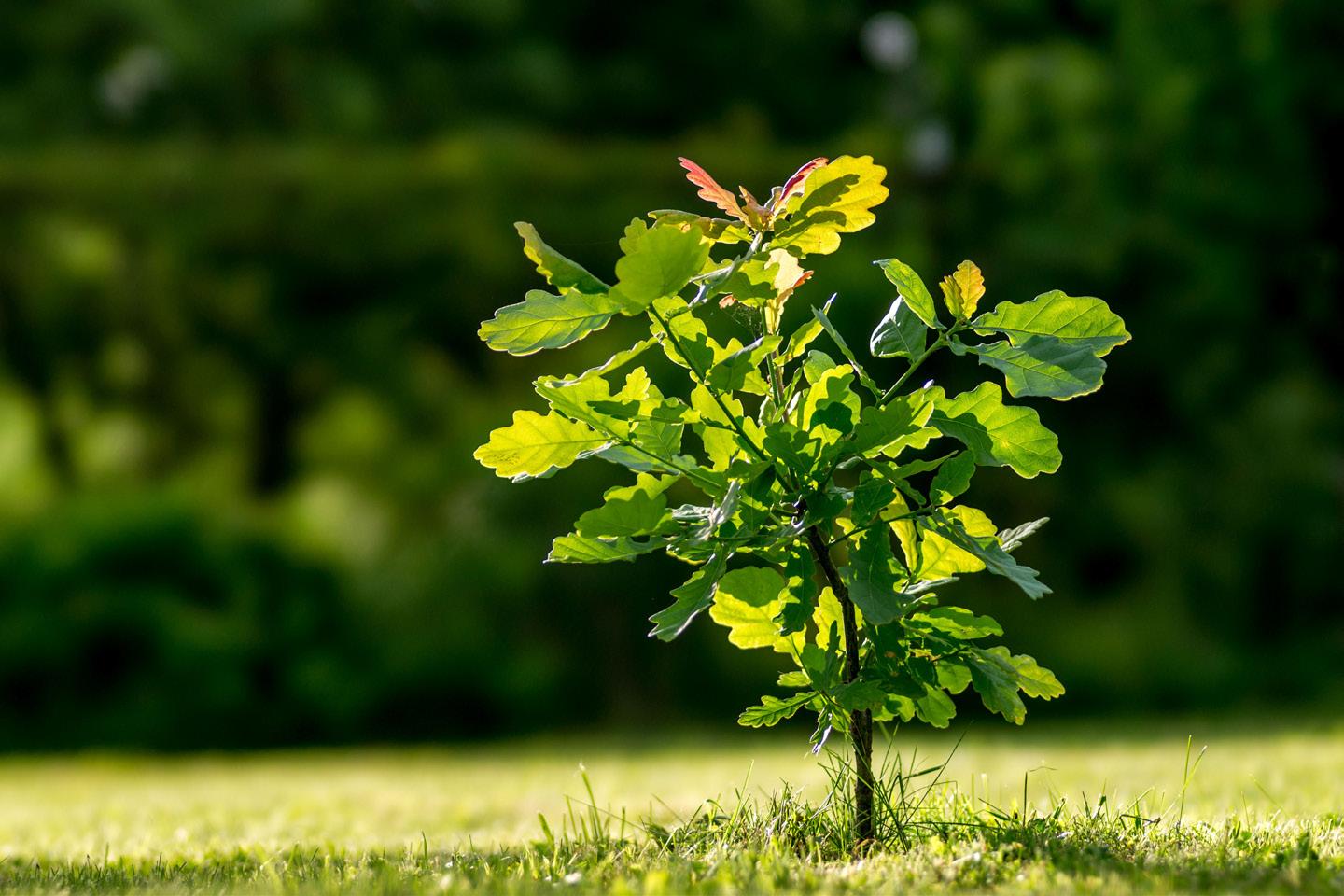
10 minute read
Pass on the Fishing Heritage
Kindness towards a child may still be remembered many years later. This column is my way of thanking a very special fisherman who was kind to a scrubby little kid almost 50 years ago.
My buddy, Bob Guerra and I both lived to fish in those simple days when dad and mom still paid the bills and school grades were our biggest worry. Our homes were close to a Missouri lake and we made housewives angry daily by stomping through flower beds while reaching our best fishing spots. Painstaking hours of research uncovered cherished places where fish gobbled down baits offered on bronze-colored hooks like piranhas feeding in a blood bank. During our formative years, the fishing bug bit us when girls were still little more than an idle curiosity and generally pests. We earned money by mowing lawns, throwing hay bales or shoveling snow to buy fishing tackle.
We constantly studied fishing articles from old periodicals that had been handed down from a neighbor. Titles like Outdoor Life, Field and Stream, Fur, Fish and Game, Argosy, True and other classic magazines enticed us with photos of huge largemouth bass jumping with a lure tucked in their jaw like a cigar in my fat grandpa’s mouth. Big bass were still a mystery we were trying to solve.
The Kansas City Sports Show in January was one of our favorite times for fighting spring fever. We loved to explore each booth, especially lure companies that were still privately owned in the 1960’s. Magazine articles taught us names like Heddon, Shakespeare and Arbogast Lures, who always had booths at the show, free brochures and occasionally real treasures like key rings. I never imagined that the gods of fishing would cast their blessings on me that cold January night.
Fred Arbogast, inventor of two of the world’s best topwater lures, the Jitterbug and The Hula Popper, died in 1947, six years before I was born. My father and grandfather had always caught bass with his Hula Poppers on our farm pond, so I paid close attention to outdoor stories about Arbogast’s Dick Kotis. The older, well-tanned gentleman was featured in magazine articles and Arbogast advertisements. He rated up there with Mickey Mantle and Roger Maris, at least in my mind.
So, it was a complete shock to see the legendary Kotis standing in his booth on that winter night in Kansas City, being ignored by the crowd. I remember this conversation as if it happened yesterday.
“Uh, Mr. Kotis,” I stammered, not used to meeting famous people.
“Yes, son, what can I do for you?” he answered in a deep, professional voice.
“Well, I, uh, just wanted to say I like your lures and have read about you in magazines.”
“So, you like to fish?” he asked.
“Well, yes sir, I do, mostly with worms under a bobber. My buddy Bob and I catch a lot of bluegill and an occasional catfish.”
“Yes, bluegill and catfish are fun to catch,” he answered, no doubt amused. “Have you ever caught a largemouth bass?” “Only small ones on worms I dug up in my mother’s garden.”
“Well, I’ll tell you what I’ll do,” he said. “My boss told me to give a couple of our best lures to a special fisherman and I think you may be the one. Here are three for you to try and then let me know if they work better than your mother’s earth worms.”
I stood there in the middle of a passing crowd and admired the items of beauty in my hands while not realizing that he actually was the boss at Arbogast. This legend of fishing had given me a Hula Popper, a Jitterbug and a Hawaiian Wiggler. Each reflected absolute beauty under the plastic confines of packaging that I wish he had autographed—but who knew about that kind of stuff at age 12?
“Uh, thank you sir,” I stammered, still in shock. “I can’t wait to try them.”
“Just don’t ever stop fishing kid,” he said.
I moved away in shock to find my buddy, Bob who had wandered another direction and stood in line waiting for a corndog behind a portly woman and her three simplelooking kids. My pal looked miserable.
“Bob, I just met Dick Kotis, and he gave me three lures,” I blurted out. “You need to forget this and get over there now in case he has more.”
“Alright, but let me get my corndog first,” he said, clearly more hungry than anxious to meet a legend bearing gifts, a mistake he regrets to this day.

We quickly returned to the Arbogast booth while Bob chewed on the corndog. By then, some young guy had replaced Mr. Kotis. Bob talked to him but didn’t even receive a brochure or a key ring. My dad drove us home that evening; me with my prize lures and Bob with indigestion.
The Midwest finally thawed out four months later. Early on a Saturday morning, I walked to the shoreline of my father’s farm pond where the surface was smooth as glass. I didn’t know how to tie a real fishing knot and quickly attached my treasured Jitterbug on old 10-pound test line with several granny knots. I examined the lure and line like an expert angler before stepping towards the muddy pond’s edge.
I had envisioned this moment over and over again during most school lectures. The time had come for me to launch my prize into a pond of hungry largemouth bass. My Zebco 33 and matching rod strained to cast the lure that was considerably heavier than a bobber, hook and worm.
The heavy lure splashed down beside a stump. I reeled once, “KER-PLUNK.”
A big bass hit the lure, made a solid run that made my Zebco drag make a sickening kind of grinding noise and “TWANG” my line broke.
I watched in horror while a heavy “V” split the surface as the bass stole my treasure. The Hula Popper lasted longer, two casts, before another good bass ripped up the surface with a ferocious attack. I managed to hang on for four good runs until “POW,” my line broke again.
I fought back tears while tying on the Hawaiian Wiggler, sort of an early type of spinnerbait and my last prized lure. I quickly wiped off the unwanted moisture from my cheek and cast out toward an old log. I managed to reel the lure several feet, feeling the satisfying vibration it made.
I managed to land a bass that probably weighed about a pound and quickly secured the flopping fish on my stringer; in 1965 we still ate bass. My next cast went out with hopes of catching one of the big bass that no doubt still had one of my lures in its mouth.
I felt the vibration one last time just before the next bass hit and “PING” the line broke. I lost my three treasured lures in less than 30 minutes. I had waited four months for a devastating lesson that would haunt me until the end of time—change the stinking fishing line. I glanced around the pond’s bank to make sure no one was close by before really letting a stream of cuss words fly. After all, I was 12 years old and boys didn’t cry under any circumstance—we cussed—unless adults were around—then we pouted.
Since that day, I have lost many lures and have forgotten about most, except for the three that were given to me many years ago by a legendary gentleman. That pond has since dried up and the lures he gave me are gone. Mr. Kotis faded into history, or so I thought.

I was inducted into the National Fresh Water Fishing Hall of Fame in 2011 as a fishing journalist. I wrote a story about Mr. Kotis for their publication. I was shocked to find he was still living in Ohio and had read my story. He, of course, was inducted too.
He contacted me and we talked over the phone, the first time since 1965. Then he sent me a nice letter with a Jitterbug and Hula Popper, this time with the boxes autographed. They are now in a shadow box in my office. I was more than gratified to tell Mr. Kotis about the kids fishing programs I had designed and that I never quit fishing!!! Mr. Kotis will always be one of my heroes and I’ll never forget his parting words that day, words you can tell your kids:
“Just don’t ever stop fishing kid.”
Kenneth L. Kieser
This shadow box hangs proudly in the author's office. (Photo: Kenneth L. Kieser)
(Top) The author's grandson has caught the fishing bug. Mr. Kotis would be proud. (Photo: Kenneth L. Kieser)
To Plant a Tree
Readers of this magazine know better than most that the results of conservation work often come slowly.
Conservation isn’t for those who need immediate gratification, and there is no better example of this than tree planting. Today’s spindly saplings are the shade of many years in the future. This spring, Magnificent Missouri and Forest ReLeaf began a three-year project to bring the shade, biodiversity and habitat of tomorrow to a stretch of the Katy Trail.
One of many tree sayings is, “A man who plants a tree plants hope.” Working with Missouri State Parks, we plan to find places to plant hope — in the form of hundreds of trees — along the Trail and on farmsteads and in front yards from McKittrick, just across the river from Hermann, all the way to St. Charles.
To celebrate the launch of our effort, we’ve published a special edition of a classic French fable, The Man Who Planted Trees by Jean Giono. In this tale, an itinerant shepherd plants 100 acorns every day for 30 years and slowly transforms an arid, lifeless place into one of beauty. The story provides a simple but powerful example of what small acts performed over a long period can accomplish. The Missouri River Valley that the Katy Trail traverses was once covered with bottomland forests of oak, pecan, sycamore and pawpaw. The river valley was cleared for agriculture a century ago, but many lone giants remain — none more impressive than the McBaine bur oak near Columbia.
Wind, water and squirrels planted specimens like this. With increasing cultivation and development, nature needs help from us to plant tomorrow’s hope.
We couldn’t think of a better way to acquaint Missourians with the value of tree planting than by creating a special edition of this book. While we are proud of the planting effort we’ll undertake over the next few years, the real hope we are planting is that these trees — and this book — will inspire others.
MWPT final Cover 6/20/07 12:15 PM Page 1 $10 USD Nature / Environment “Jean Giono’s story of a man’s generosity to nature—and through nature, to other humans—surely belongs among the most moving and endearing statements of our hope. In the figure of Elzéard Bouffier, Giono summarizes the best that can be said of our species. It has given me much joy to reread this story.” —WENDELL BERRY This extraordinary fable brings to life a shepherd who plants one hundred acorns a day for thirty years. The shepherd’s tireless efforts transform the countryside, revitalize his community, and teach us about hope, humanity, and our own ability to create change in the world. Richly illustrated by master engraver Michael McCurdy, this edition includes an inspiring foreword by Nobel Laureate Wangari Maathai, whose Green Belt Movement has planted millions of trees and brought hope to people throughout Kenya. In his afterword, Andy Lipkis tells of founding TreePeople and planting trees in the unlikely ecosystems of Los Angeles, and provides practical resources for action in any community. Jean Giono (1895–1970), the only son of a cobbler and a laundress, was one of France’s greatest writers and won the Prix de Monaco, for the most outstanding collected work by a French writer, among other awards. Chelsea Green Publishing White River Junction, Vermont 802-295-6300 www.chelseagreen.com Giono
THEMANWHOPLANTEDTREES
C HELSEA G REEN
a story by Jean Giono
W O O D E NGR AVINGS BY M ICHAE L M C C URDY
A S P ECIAL E DITION F OR M A GNI FICENT M ISSOURI
Foreword by DAN BURKHARDT
Magnificent Missouri’s special edition of The Man Who Planted Trees is available at MagnificentMissouri.org.
Dan Burkhardt











